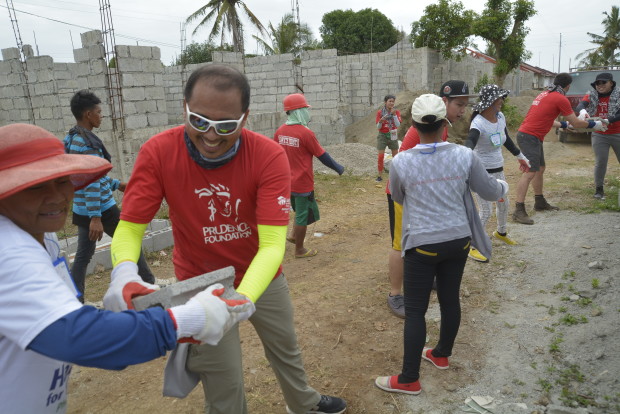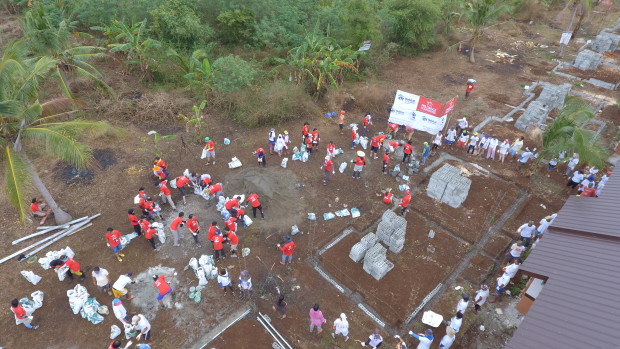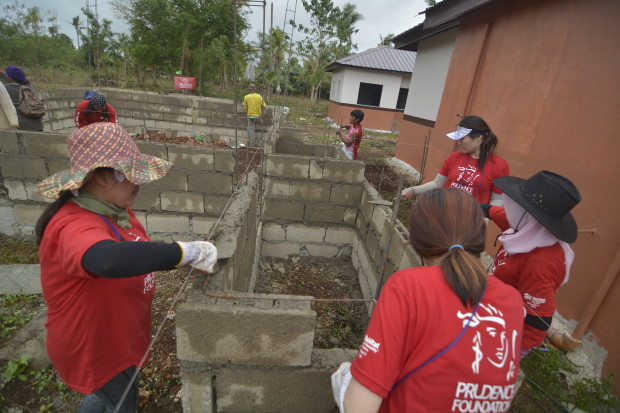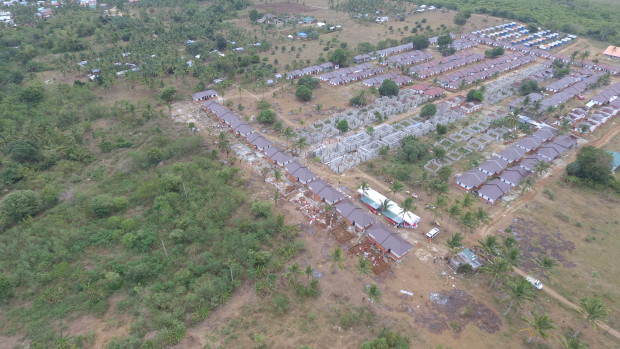In post-Yolanda Bantayan, hope rises with new homes
BANTAYAN ISLAND, Cebu—When Supertyphoon “Yolanda” (international name: Haiyan) pummeled the Visayas in November 2013, the eyes of the world and much of the international aid that poured into the country centered in Tacloban City—one of the areas severely hit by the strongest storm that made landfall on record. But not so far away, in a small island at the northern end of Cebu, the suffering of thousands of families left devastated and homeless by the typhoon was just as valid, sans the media spotlight.
Almost four years since the tragedy, seaweed farmer Mary Jane Escaran can still remember the horror of that fateful day when she and her two children had to leave their house in Panangatan, one of the islets in Bantayan, to evacuate to a gymnasium in the mainland. In tears, the 33-year-old mother recalled how her kids tightly clung to her as they feared for their lives and for the safety of their father, a fisherman, who was stuck in another islet when Yolanda battered Bantayan.
“November 8 nang dumating ang bagyo, nasira na ang gym, nagliparan na ang mga bubong, nag-iyakan na ang mga tao. Pati ang mga anak ko nakahawak na sa akin, umiiyak. Sabi nila, ‘Mama ‘yung papa namin,’” Escaran said in an interview before going into a pause, struggling to hold her tears back. “Sa awa ng Diyos ligtas naman siya.”
(The typhoon came November 8, the gym was destroyed, the roofs were flying off, and everyone was weeping. My children clung to me, also crying. They said, “Mama, what about our papa.” By God’s mercy, he was safe.)
“Tinignan namin ‘yung isla namin, walang-wala. Kapag nasa pier kasi kayo, makikita na ‘yung isla namin at ‘yung mga bahay. ‘Yung mga tao, nag-iyakan na. Wala kaming masakyan pabalik kasi sira ang mga bangka. Tumawid na lang kami makauwi lang, low tide kasi… Wala na talaga lahat. Bagsak na. Lahat ng mga gamit namin, mga gamit ng mga anak ko sa eskwela, basa na,” she said.
(We looked at our island, it was utterly destroyed. When you’re at the pier, you can see our island and our houses. Everyone was crying. There was no transportation going back because all the boats were destroyed. We just crossed just to get home since it was low tide… Everything was gone. Knocked down. All our belongings, my children’s things for school, it was all wet.)
Escaran was just one of the estimated 90 percent of the island’s population displaced by the super typhoon, which killed at least 6,000 and affected over 14 million people in the Philippines. No one died in Bantayan, but the residents of the community that heavily relied on fishing were left with literally nothing as their homes and sources of livelihood were severely damaged.
“Noong nangyari ‘yun, sabi namin sa mga sarili namin, paano kami babangon? Sira na ‘yung pang-hanapbuhay namin, ano pa ang makukuha namin sa laot ngayong sira na ang dagat? Nakataas at umaasa lang kami sa Panginoon, unti-unti lang,” Escaran said.
(When that happened, we asked ourselves, how will we get back up on our feet? Our livelihood was destroyed, what else can we catch now that the sea is destroyed? We were just trusting in God, little by little.)

Prudential volunteers from different countries across Asia pass on hallow blocks during the construction of disaster-resilient homes in Barangay Sulangan for the victims of super typhoon Yolanda. Photo from Prudence Foundation
Back to its flare
But like in any misfortune, when faced with the worst, there’s no really other way to go but forward. Four years have passed since Yolanda, and while Escaran and the rest of the Bantayan community have yet to fully recover one step at a time, seeing her smile again without a trace of loss and suffering was unimaginable back then. The world seems to never run out of kindness, and this time, hope springs in the form of new houses.
Shortly after the super typhoon’s onslaught in 2013, the Hong Kong-based Prudence Foundation, the community investment arm of Prudential Corporation Asia, pledged 2 million US dollars for the relief and rehabilitation efforts in Yolanda-stricken areas. Part of its commitment is a volunteer program for the construction of 133 disaster-resilient homes in barangays Maricaban and Sulangan in the municipality of Santa Fe, in partnership with Habitat for Humanity Philippines.
For the past three years, the foundation tapped groups of employee-volunteers from its different units across Asia to assist the beneficiaries in building the houses for the Bantayan community. In September 2015, 64 of the targeted homes were completed and turned over to the home partners, including 183 motorized fishing boats with nets and 140 pedicabs or cycle rickshaws. Last week, from March 18 to 25, a group of about 70 volunteers from different Asian countries took the time off their corporate grind and flew to Bantayan to buckle down and do some serious physical work for the final leg of the volunteer program.
Marc Fancy, executive director of Prudence Foundation, said the situation in Bantayan now was very different compared to when their team first arrived just a few years ago.
“The work is very physical but it’s very useful because when we’re not there, there was a construction team but we saw the limits of what they can do. When you get a hundred people coming in for a week you can actually get a lot of work done,” Fancy said in a sit-down interview. “It’s quite emotional for us because this is our very last trip. Four years of our life has been coming back to Bantayan, so Bantayan actually has a big piece of my heart, and I’m not the only one.”
“When I first went here, there was a lot of devastation. It’s not the worst I’ve ever seen, but it doesn’t matter. When someone lost their house, it doesn’t matter how they lost it. They’ve lost their home. The relocation tent is useful but it’s not the best thing to live in for a year especially when you have a family. You don’t want people rebuilding exactly where the disasters happened because there are sanitation and health issues, among others. So when we first arrived that’s the situation. It’s very different to where Bantayan is now; it’s back to its touristic flare. You wouldn’t be able to tell that a disaster happened,” he added.
Sense of dignity
Architect Erly Kris Faeldonia of Habitat Philippines said an innovated structural design was employed in making the duplex Bantayan houses to make it more disaster-resilient, including a different roof sloping and overhang, nonconventional light blocks, and other structural elements to support the walls. The 60-square meter houses can supposedly withstand magnitude 8 earthquakes and winds of up to 275 kilometers per hour.
After an initial assessment of profiles, the beneficiaries coming mostly from the islets of Bantayan were chosen by a selection committee comprised of members from the Municipal Social Welfare Development, Rural Health Unit, the private sector including the church, and the local interagency committee from the local government unit. According to Loriefe Rota, community development officer of Habitat, qualified beneficiaries included those whose houses were totally damaged, those who stay within the danger zone or 40 meters from the sea shore, and indigent families.
To cultivate a sense of ownership and a culture of community among the home partners, Fancy said the houses were not just mere freebies or hand-outs as those who passed the screening process would have to render sweat equity of at least 400 hours.
“I’m almost blown away when I come back there. They always care about the community. They care about the houses and they’re very proud of them. There’s a sense of kinship there because together in that journey; they’ve seen this land empty, built houses and moved in and they’re very proud of the house of their own,” Fancy said, recalling how the occupants of the Maricaban site formed a Christmas tree using recycled plastic bottles during their first Christmas in the community last December.
“And it’s pretty cool because you get people back the sense of humanity. When you’ve lost everything, it’s very important to get back on your feet and have a bit of pride and dignity in your life and try to help to take ownership of that dignity so they would not depend on other people all the time,” he added.
Reality check
Beyond building houses for people, Fancy said the initiative has evolved into something bigger and more holistic, as it transformed the lives not only of the homeless Yolanda victims but also of the volunteers. One afternoon in the Sulungan build site, as they stand and line up together under the alternating scorching heat of the sun and drizzling of the rain, the author saw that they were not just passing on concrete blocks, but also stories and lessons of hope with a smile on their faces.
“The important story from our point is, giving money is easy. You can donate a check and it’s easy. Any company can do that. But for us it is important that we just don’t see the houses being built, that we also have sweat equity, that we also get blisters in building. The thing I like about this program is our staff are privileged guys. It’s important in your life that you get to be side by side with people who are not so privileged but as an equal and helping together working as a team. They learned a lot from the people of Bantayan who lost a lot but whose spirit and attitude have this robustness, has a positive effect on us,” Fancy said.
“You think you’re trying to help. The irony is you get back as much as you poured in and sometimes I think that’s the very healthy thing. People think that coming from an angle that yes, we’re gonna help these victims, but ironically, the victims also end up helping them and it becomes a life experience. And watching that is a privilege,” he said.
Francis Macatulad, head of Habitat Philippines’ volunteer program marketing group, added: “Often, the volunteers keep telling me that they just did not help transform the lives of others, in the process of working, they’ve transformed their lives as well. Rebuilding a life starts with rebuilding a home, because it’s the start of other good things.”
The most challenging part of the four-year experience, Fancy said, was being confronted with reality and being face-to-face with people who had lost everything. But Fancy said the foundation did not play God and pretend to have all the answers and solutions to the victims’ plight. What they did, he noted, was to embark on a journey to help the homeless get back on their feet by helping in as much as they can.
“Things get broken and things can be repaired. A house is tangible. A life is harder to rebuild. I’ve been to other countries like Japan and met children who lost both of their parents. How do you tell that child that things are going to be okay?” Fancy said.
“When things happen really badly, people tend to question everything, Why us? What is this all about? When you get to help people regain a sense of purpose, rebuilding a community, a sense of direction, a future to look forward to for their children, then that’s putting them on the trajectory of life, and hopefully our work contributes to that,” he added.
Aside from the Philippines, Prudential volunteers have also helped victims of disasters across Asia, including the 2008 Sichuan earthquake in China that claimed more than 70,000 lives, a magnitude 7.9 earthquake in Indonesia in 2009, the Great East Japan Earthquake and tsunami in 2011, and flash floods in Thailand in 2012.
Seed of hope
RJ Estayola, assistant manager of Creative Services at Pru Life UK Philippines, was fortunate enough to be a part of all Bantayan programs in the past years. What made every trip to the island different, he said, was meeting people from all walks of life and being able to help on a larger scope with the best of his capability.
“You get a sense of fulfillment wherein you are a part of the house that they have now or the house that we are building, even if isang hollow block lang ‘yan (it’s just one hollow block). It’s an eye opener on how privileged I am living in Manila and living in a very modern setting na kahit na mabagyo (even though it storms), we’re secured. Wherein dito, when you hear their stories kung gaano sila katakot noong nagkabagyo (how they were terrified during the typhoon), they were crying, it really breaks your heart. And at the same time, it urges you to do more, to help more, and to help them feel better,” Estayola said in an interview.
“I know I cannot help everybody, but I can help as much as I can… My hope for Bantayan is for them to actually recover from the disaster that is Yolanda and for the houses to be a source of inspiration for all the people, for them to work harder and start a new life. We planted it as a seed of hope for them. We may not have helped the whole island, but we can start here and inspire them to work harder for their families,” he added.
Fancy has been exposed to different disasters and met people who have lost their entire homes and families. Asked about what made Filipino survivors different from the other nationalities in terms of dealing with loss, he spoke of a unique and “unbelievable” human spirit of being able to rise and smile again even after a tragedy. There will always be issues hounding the complex process of disaster response, but sometimes, it takes something tragic for lessons to be learned and to bring out the best in everyone.
“There is an unbelievable Filipino resilience and attitude that is Filipino, you own it, which is this unbelievable spirit of getting back on your feet with a smile and fight for another day with a smile, and I find that quite unbelievable. And very soon after Yolanda, in the places that I was able to go to, that was very evident, whether it was a kid, a grandmother, a dad, or whoever. No matter what walk of life, there is a very distinct Filipino spirit, and that’s magic. I don’t know how you guys have it, but that’s something you got to keep because that’s pretty special,” Fancy said.
“I learned a lot from Filipinos, from the people in Bantayan. I learned a lot about resilience. I’ve learned about humanity. One of the things I love the most is the world comes together. You’ve got people from different walks of life here for the same cause—to get working side by side. That’s a lot. You come here thinking you want to help but you realize actually that you get helped an awful lot out of it,” he added. JE/rga
RELATED STORIES
New homes, new life for ‘Yolanda’ survivors
Rebuilding homes, lives in Yolanda-shattered Bantayan
‘Yolanda’ victims receive disaster-resistant homes

















